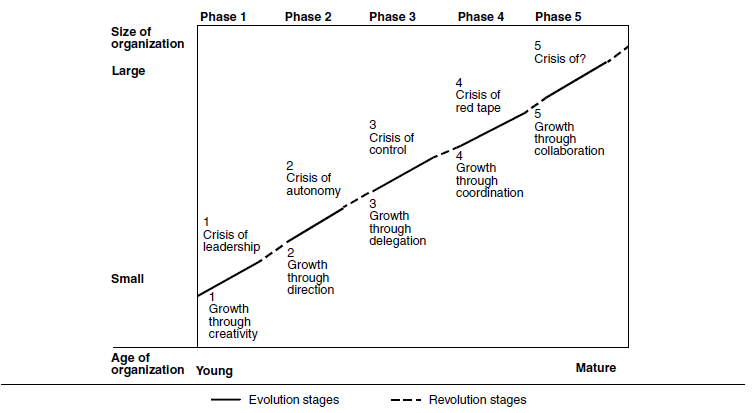Most new businesses do not survive for more than six years. In today’s world when the external environment is changing fast, – the Covid 19 pandemic has opened the eyes of many small businesses – it is even more important to think about what small businesses can do to survive in the short-term and scale up in the long-run. Almost all entrepreneurs experience common problems at similar stages in their business journey. Some of the key challenges they face are inconsistent cash-flow, micromanagement, lack of processes and agile thinking. Therefore, it is important to first understand how small businesses grow & then what they can do to scale up.
Following are the typical growth phases in any business. Let us look at each of these phases and activities involved.

Phase 1 -Existence – At this stage, a new business is just trying to stay afloat and is looking for a customer who is willing to try out its products or services. The goal at this stage is to acquire a customer to prove that products or services provided by the company have customers in the market. The owner must play all the roles in the organization. The owner or the entrepreneur must drive the business 24X7.
Phase 2 – Survival – After proving the usefulness of its products or services, the next goal is to get more customers, so that business survives by recovering costs and if lucky, generate a small profit. However, the business will survive only if its customers pay and the new customers are willing to try out company products or services. The owner makes all the decisions and at this stage, the organization is still small.
Phase 3 – Growth – This is an exciting phase of the business. Business owner has a lot more confidence now in his/her own abilities and is willing to invest in growth. The owner hires a few more people to take care of sales and operations. However, the entire business is still micro-managed by the owner – It is one of the biggest growth challenges. The owner is also careful about costs and therefore hires mediocre talent from the market. Company grows, but the rate remains low. On the positive side, business turns profitable and the owner continues to operate the business in a sub-optimal way – year after year. The full potential of business is not achieved, and the growth stagnates.
Phase 4 – Take off (Scaling up) – After growing the business for a few years and after experiencing moderate success, the owner has three choices. a. To continue with the same pace and let the business grow at the current rate b. sell of the business c. To scale up and make it big. Many owners and entrepreneurs would want to scale up, however, usually do not know how to do it. In some cases, they do not have the same energy they used to have in the past, and many times they do not have the internal talent that can take charge and lead this phase of the business.
Phase 5 – Maturity – This is a dream for any small business. The owner or entrepreneur would want to see their business grow and achieve phase 5. A very few businesses get to this phase due to variety of reasons.
In this article, we will focus on phase 3 and 4 while keeping in mind today’s context. Many organizations find it difficult to move from a growth phase to a Take-off (scaling-up) phase. However, when the market demand drops and the growth slows, organization needs to focus on surviving first and then undertake planning for the next phase.
- Focus on predictable business – This business is company’s bread and butter and is important for its survival in the short-term. The company needs to focus on providing the best service to its existing customers and find ways to get a predictable cash-flow. It also needs to build more responsive teams to deliver better service at a lower cost. The key here is to hold on to your existing customers to get enough cash-flow to survive. If the business environment turns better, the company can focus on investing in building processes and platforms with cross-functional teams to scale up.
- Prioritization – Every company needs to have a process to prioritize its work. In today’s environment, companies are willing to work without it as the amount of work and deliveries are relatively few and a formal prioritization may not be needed. However, as business environment improves, the basic rules of prioritization must be put in place. Otherwise, every function uses their own discretion to prioritize creating confusion and chaos.
- Effective Delegation – Until phase 3, the owner is involved in every decision in the organization – critical or routine. When the business is trying to survive, the micromanagement of resources and processes is the right thing to do, however, it is the biggest impediment as business starts growing. To grow faster, the owner needs to learn the art of delegating. This means letting go of certain control. Owner must only involve himself in high-impact decisions. Many critical decisions must be delegated. This helps the entrepreneur to focus on scaling up and helps build the second line of leadership.
However, in addition to the changes explained above – as organization starts thinking about moving from the growth phase to the take-off phase – it must think and internalize the six key steps:
- Think Big – Many leadership teams find it challenging to visualize how their company would like when it grows three-fold or more. It is not easy to visualize the type of people, processes, technology, and business model that would be in place.
- Extensive Customer Analysis – After step one, companies need to do extensive analysis of existing customer base. Companies need to ask questions like, what would our key customers need 2 years from now? How are the markets served by our customers changing? What new customers can we target who would benefit from the products and services we provide. etc.
- Systems, Drivers and Products/Solutions approach – In a typical set up, companies have sales organization to sell its products/services or solutions. This allows companies to grow up to a point. However, to grow further, companies need to think about systems and drivers along with products and services. The focus must be on creating system or a platform, that is independent of any person or a set of people. Use of digital technologies is the key for small businesses to make this happen quickly.
-
Smart resource allocation and
managing cash-flow – The next
key area is to select a proper
method for resource allocation.
Companies that grow their
businesses significantly have
different ways to allocate
resources. They do not allocate
resources based only on the size
of the business unit or the
revenues generated by the unit
in the previous year.
Management of cash-flow is another challenge for small businesses. As the environment gets tough, the payments get delayed and cash-flow gets squeezed. Small businesses need to do scenario planning more regularly to see how their cash-flows may change for changing scenarios.
- Stable ecosystem – Building an ecosystem that creates a win-win situation for everyone is a key to building long-term sustainable growth and to keep competition out of the market. Ecosystem analysis includes understanding of roles of various partners, their business drivers, and their profitability matrix etc. on a long-term basis
- Financial and other leverage – Some companies grow at above normal growth rates when the markets are good, however, they fall substantially when the market turns sour. Understanding financial leverage and using it appropriately is one of the key factors in scaling up. Along with financial leverage, leveraging relationships go a long way in growing beyond the average rate of growth.
In summary, many small businesses aspire to scale up or grow at a much higher rate, however, many do not know how to get there. They need a game plan or a roadmap to achieve this goal. At Koinvent, we help small companies build the right mindset, help them understand the key steps and help them to implement the roadmap. If you want to talk to us, please contact us at contact@koinvent.com
Author,
Milind Pandit
Koinvent
Business Solutions
References:
- Five Stages of Small Business Growth by Neil C Churchill and Virginia Lewis Published in the Harvard Business Review (May June 1983)
- The future of small and medium business lies in digital – https://www.entrepreneur.com/article/287311
- Six steps of scaling a business. https://www.forbes.com/sites/philipsalter/2016/05/02/the-six-steps-to-scaling-a-business/#dbe3ae71ca96
 Client Login
Client Login
 Client
Login
Client
Login






0 Comments